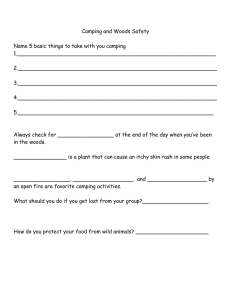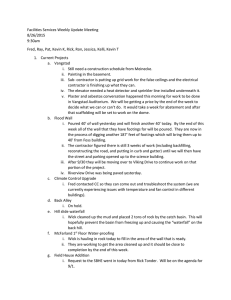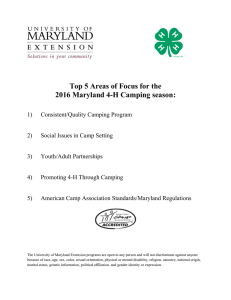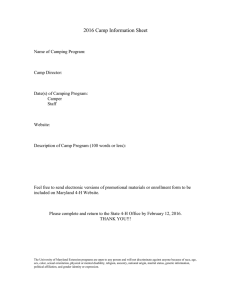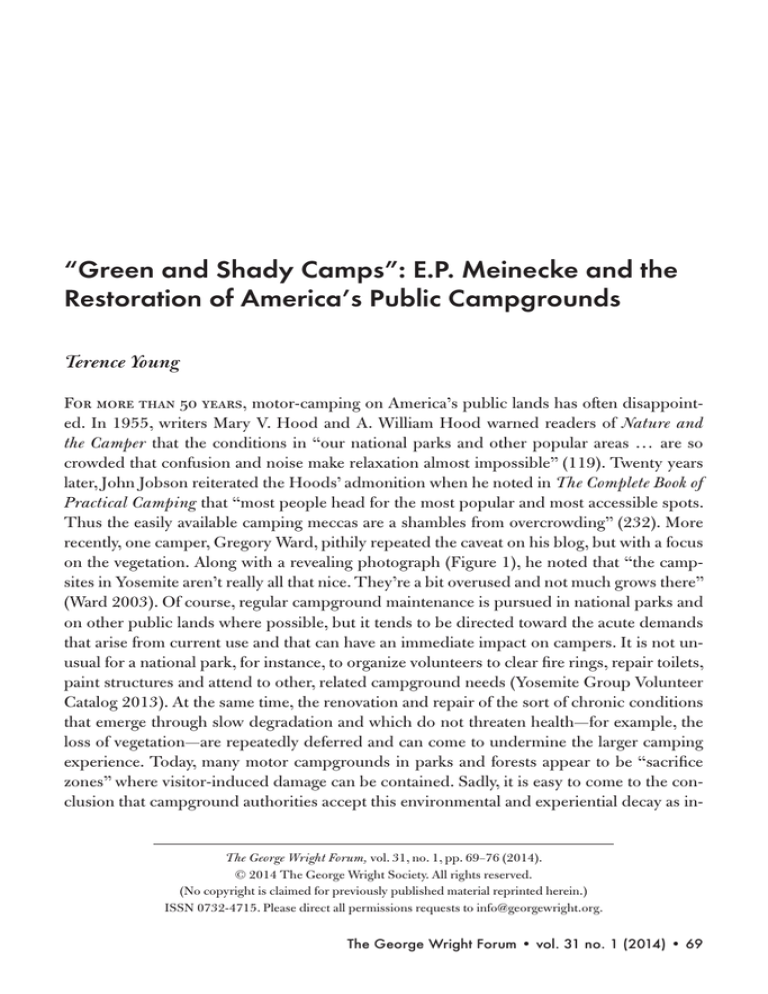
“Green and Shady Camps”: E.P. Meinecke and the
Restoration of America’s Public Campgrounds
Terence Young
For more than 50 years, motor-camping on America’s public lands has often disappointed. In 1955, writers Mary V. Hood and A. William Hood warned readers of Nature and
the Camper that the conditions in “our national parks and other popular areas … are so
crowded that confusion and noise make relaxation almost impossible” (119). Twenty years
later, John Jobson reiterated the Hoods’ admonition when he noted in The Complete Book of
Practical Camping that “most people head for the most popular and most accessible spots.
Thus the easily available camping meccas are a shambles from overcrowding” (232). More
recently, one camper, Gregory Ward, pithily repeated the caveat on his blog, but with a focus
on the vegetation. Along with a revealing photograph (Figure 1), he noted that “the campsites in Yosemite aren’t really all that nice. They’re a bit overused and not much grows there”
(Ward 2003). Of course, regular campground maintenance is pursued in national parks and
on other public lands where possible, but it tends to be directed toward the acute demands
that arise from current use and that can have an immediate impact on campers. It is not unusual for a national park, for instance, to organize volunteers to clear fire rings, repair toilets,
paint structures and attend to other, related campground needs (Yosemite Group Volunteer
Catalog 2013). At the same time, the renovation and repair of the sort of chronic conditions
that emerge through slow degradation and which do not threaten health—for example, the
loss of vegetation—are repeatedly deferred and can come to undermine the larger camping
experience. Today, many motor campgrounds in parks and forests appear to be “sacrifice
zones” where visitor-induced damage can be contained. Sadly, it is easy to come to the conclusion that campground authorities accept this environmental and experiential decay as inThe George Wright Forum, vol. 31, no. 1, pp. 69–76 (2014).
© 2014 The George Wright Society. All rights reserved.
(No copyright is claimed for previously published material reprinted herein.)
ISSN 0732-4715. Please direct all permissions requests to info@georgewright.org.
The George Wright Forum • vol. 31 no. 1 (2014) • 69
Figure 1. “The campsites in Yosemite aren’t really all that nice. They’re a bit overused, and not much
grows there.” Photo courtesy of Gregory Ward.
evitable and one-way. History, however, demonstrates that campground deterioration can be
directly addressed and reversed.
Camping has been an enormously popular American pastime for nearly a century.
According to the Outdoor Foundation, approximately 15% of the population (42.5 million)
camped during 2011 and this figure has held relatively steady for years (Outdoor Foundation
2012: 14, 23). By contrast, the early 20th century was a period of booming growth, with the
number of American campers jumping from only 300,000 in 1915, to more than 3,000,000
by 1930 (Statistical History of the United States 1965: 222). The primary cause for this
skyrocketing influx was the advent of the inexpensive automobile, which transformed the
camping experience. Cars made it possible to carry a family plus large amounts of equipment
and supplies over great distances at an affordable cost. Once autos came within reach of
working-class families, the number of campers ballooned. Unfortunately the quality of popular camping destinations deteriorated under this wave of enthusiasts because camping largely
had been unregulated in the nation’s protected areas since its beginnings in the 19th century.
In this unorganized state, unlimited numbers of campers were free to haphazardly set up
their equipment at any attractive, public location they could access, for example in Stoneman
Meadow at Yosemite (Figure 2) (Demars 1991).
Crowding, noise, surface water pollution, and soil pollution became common as people
and their machines pervaded camping areas, but the greatest casualty of unregulated camping was vegetation. Grasses and forbs, as well as shrubs and trees, disappeared from popular
70 • The George Wright Forum • vol. 31 no. 1 (2014)
Figure 2. Unregulated campers in Stone­
man Meadow, Yosemite National Park in
1927. Photograph courtesy of NPS.
destinations as the number of campers climbed. By the late 1920s, public
campgrounds nationwide were being
abandoned as degraded and unappealing (McClelland 1998). Concerned
about the skyrocketing loss of vegetation
in campgrounds and other high-traffic
areas, national park and forest authorities turned to E.P. Meinecke for assistance. His evolving prescriptions would
consistently address vegetational damage, but over time, they would also come
to focus on the camping experience.
Emilio Pepe Meinecke, widely
known as “Doc,” was born in Alameda,
California, in 1869 but he traveled to
Germany, his parents’ homeland, to earn
his doctorate in Botany from the prestigious University of Heidelberg in 1893 (Figure 3). Cosmopolitan and peripatetic, he worked
and taught in Germany and Argentina for about a decade before returning to San Francisco,
California, in 1909 to accept a post at the US Department of Agriculture’s Bureau of Plant
Industry (BPI) as consulting pathologist for the US Forest Service’s California District. In
1928, Meinecke also became consulting pathologist for the National Park Service (Wagener
et al. 1957).
During his first 16 years with the BPI, Meinecke focused professionally on trees damaged by insects, diseases, and other natural pests, but then in 1925, the Park Service approached him with a question about human-caused injuries to Sequoia gigantea, or “Big
Trees,” at Sequoia National Park. How, they asked, can we mitigate the negative impacts of
intensive camping in the most picturesque tree groves and of people’s heavy and unrestricted
use of the same? Intrigued, Meinecke visited the park in May 1926 where he discovered a
grossly imbalanced and dire situation. The public, Meinecke warned, was loving the trees to
death. Big Trees were clearly very attractive to visitors and “the bigger the tree the greater is
the desire of the tourist to make its acquaintance” (Meinecke 1926: 12). Unfortunately, the
Sequoias could not withstand their suitors’ too constant attentions. In a zone adjacent to the
biggest trees, “the ground for many feet in radius is compacted to a cement-like consistency” and the most important and active roots had been compressed to the point of destruction by the simple act of walking (Meinecke 1926: 10). Without remediation, the oldest Big
Trees would soon die so Meinecke recommended that the degraded zones be reforested with
Sequoias, Douglas firs, and all the other species that had been lost to trampling. In light of
this prescription, Superintendent John White ordered his staff to begin the removal of campThe George Wright Forum • vol. 31 no. 1 (2014) • 71
Figure 3. E.P. “Doc” Meinecke around 1928. Photo courtesy of National Park Service Historic Photograph Collection.
sites adjacent to any Big Trees and the replanting
of the forest. Meinecke had begun his scientific
inquiry into the relationship between vegetation
and camping.
Word of Meinecke’s analysis spread quickly among protected-area administrators and
the following year, 1927, he accepted an invitation to assess the forest and camping situation
in California’s state redwood parks (Meinecke
1928). Visiting several of the most popular locations, Meinecke found conditions similar to those
at Sequoia National Park—severe environmental
degradation from an “excessive concentration of
traffic.” This time he offered four recommendations. First, conflicting park functions should be
spatially segregated from each other. The redwood groves, which visitors found most appealing and which tended to be near the centers of
parks, needed to be managed in a manner distinct from the less valuable areas near park
edges. Deeply symbolic, redwoods were each parks’ primary feature and principal amenity
so their groves should not include any commercial concessions or other artificial features.
An increased level of vegetation protection would result, but the principal product of this
change, Meinecke argued for the first time, would be an improved visitor experience through
an enhanced sense of place. “The main groups of Redwoods,” he offered, will “resume the
rank they held before a heavy and uncontrollable invasion tended to cheapen their prodigious beauty in the eyes of the public.” Second, Meinecke relatedly noted that camping areas
tended to suffer the heaviest trampling and consequently the worst soil compaction so he
recommended that camping be “absolutely banned from the main [redwood settings] and
concentrated in the marginal areas … [where] it can do little harm.” Third, Meinecke took
aim at the damage caused by the unregulated movement of pedestrians when he advised that
trails be established through redwood groves and the public trained to stay on them. Such
training, however, would impact the camping experience and had to be handled thoughtfully.
In a city park, signs and fences could be constructed to constrain and direct movement, but,
Meinecke warned, “both are distinctively objectionable in the atmosphere of the Redwood
parks and should be used only as an ultimate resort.” Instead, authorities were encouraged to
take a naturalistic approach where controlling structures would be subordinated to the environment. A carefully placed log, fallen limb, or rock, or a judiciously planted shrub “serves
as well as a solid fence…. The best trail is the one which leads through green undergrowth
taking the place of a fence.” Finally, Meinecke recommended that trampled areas be restored.
Soil aeration and time would most facilitate recovery, but planting indigenous species could
72 • The George Wright Forum • vol. 31 no. 1 (2014)
help too. Again, however, he was concerned that this restoration appear natural, so he cautioned that “unless [replanting] is done with great skill the effect will be one of artificiality
and consequently undesirable” (Meinecke 1928: 13–15).
The Sequoia National Park and California state park reports demonstrate Meinecke’s
preference for spatial strategies combined with behavior-shaping, naturalistic features to reduce and mitigate the damage that unrestrained visitors had on the physical environment. At
the same time, the reports reveal the first glimmerings of an awareness of connections between
vegetation and the camping experience. Subsequent consultations at Yosemite, Glacier, Mesa
Verde, and other national parks reinforced Meinecke’s awareness and soon he would produce the comprehensive plan that transformed the campground into a device that can both
protect the environment and enhance the camping experience. Apparently Meinecke began
the development of his plan in spring 1931 when L.A. Barrett, the Forest Service’s assistant
forester for California’s lands and recreation, asked the pathologist to join him on a summer
inspection of Forest Service campgrounds in the eastern Sierra Nevada and to produce a formal assessment of the increasingly stark damage at these sites. After a winter of analysis and
contemplation, Meinecke delivered his groundbreaking report entitled “A Camp Ground
Policy” in April 1932.1
As he had in his previous assessments, Meinecke began with the focus on vegetation
loss, but he singled out the automobile as the cause rather than people on foot. Unlike pedestrians, cars more thoroughly crushed continuous tracks of ground, broke branches, barked
trees, and poisoned the earth with motor oil. “A single invasion of a new camp site by an
automobile would soon be repaired,” he admitted, but that was not the situation. “It is the
constant repetition of the injurious action, day after day, year after year, that ends in disaster,
and the final result is the destruction of the elements that make a certain locality suitable for
camping” (Meinecke 1932: 2) According to Meinecke, a camper using an unregulated or
“self-made” campsite (Figure 4) pulled off the road, drove around a central clump of trees,
and selected a tent site. Once the tent was pitched, the places for a campfire/stove and for the
table were selected. When leaving, the camper did not reverse his travel but continued forward in order to loop back out to the road. Three points—A, B, and C in the figure—became
“keys” and progressively lost vegetation as they were struck by cars. As a consequence, each
key retreated “until an artificial desert mars the entrance to the camp. Similar processes go
on within the camp site until the formerly green and attractive camp is rendered unsightly,
shadeless and finally useless” (Meinecke 1932: 7).
To remedy the situation, urged Meinecke, the Forest Service needed to intercede with his
novel campground plan. In particular, Meinecke employed a four-point spatial strategy to reduce the randomness of camper movement (Figure 5). First, authorities should designate individual campsites of roughly equal size, each with its own “address.” Second, each campsite
should also have a fixed stove, table, and tent pad. The unchanging spatial relations between
these elements would reduce damage across most of a campsite by concentrating camper
movements into the central area between them. Third, since cars were the principal culprit,
they had to be confined to designated roads, which in the Meinecke proposal were one-way.
The roads, in their turn, made possible the fourth and “essential feature of the plan” possible:
a “garage spur” where campers could park their autos and have comfortable and focused
access to the table, stove and tent pad at each camp site. Central to his proposal, Meinecke
The George Wright Forum • vol. 31 no. 1 (2014) • 73
Figure 4. An unregulated or “selfmade” campsite. Source: Meinecke
1932.
emphasized that each garage spur
had to be “plainly marked” and
“immediately recognized as such”
(Meinecke 1932: 11). How were
authorities to keep campers from
ignoring a garage spur and simply
moving their cars elsewhere in the
campsite? By using “the tourist’s
desire to protect his property, particularly his car, from injury.” At
strategic points around the spur,
obstacles “sufficiently heavy so as
not to invite moving by the average camper, are placed in such a
way that, in self-preservation, the
camper will not drive over them.”
Of course, Meinecke reminded his readers, “the average tourist is willing to conform, according to his understanding, to what he is supposed to do in the forest…. Still, it must be kept
in mind that the tourist when he visits the forest seeks release from the restrictions of town
and city life. He wants a certain amount of freedom, and in this mood he resents too obvious
directions such as signboards with prohibitions and demands” (Meinecke 1932: 9). As an
alternative, Meinecke emphasized a naturalistic approach by promoting the use of boulders
or other large objects to constrain automobile movement, which would simultaneously reduce vegetation loss and allow two campsites to be designated in the same space that a single
unregulated one had used.
Finally, Meinecke linked his comprehensive plan to the camping experience. The average
camper, Meinecke offered, wanted “green and shady camps” so he recommended the temporary withdrawal of older, damaged campsites (or even larger subunits) and their re-planting with“native trees at strategic points” (Meinecke 1932: 14, 16). However, he cautioned,
campers would not be easy to satisfy because they held two conflicting views about campgrounds and the camping experience. On the one hand, “the city man does not feel at home
in what to him is wild country…. [As a consequence,] he prefers the semi-domestication
of nearby camps, easily reached and easily left.” On the other hand, the same individual has
come camping to be released from “the restrictions of town and city.” Therefore, Meinecke
cautioned, the planting and maintenance of vegetation, like the constraining objects around a
garage spur, had to be pursued “in close imitation of the natural type…. Landscaping in the
usual sense,” that is, something similar to what one would find in a city park, “has no place …
where the visitor seeks at least the illusion of wildness” (Meinecke 1932: 9, 14). The average
camper, Meinecke explained, resented anything, even vegetation, that too strongly resembled
life at home.
74 • The George Wright Forum • vol. 31 no. 1 (2014)
Figure 5. Two Meinecke campsites.
Source: Meinecke 1932.
The Forest and Park services
quickly embraced Meinecke’s pro­
posals. By fall 1932, thousands
of copies of his plan had been
distributed throughout both services and, in the words of National
Park Service historian Linda
McClelland, “major changes began to appear in the[ir] campgrounds.” Soon, public campgrounds nationwide incorporated
defined roads, designated campsites, garage spurs, and controlling
obstacles to protect vegetation.
So rapid and universal was the
adoption of Meinecke’s approach
that the term “meineckizing campgrounds” became a commonplace among CCC (Civilian
Conservation Corps) landscape architects and supervisors in the 1930s, and could still be
heard among camping authorities into the 1950s (McClelland 1998: 281). Today the majority of America’s public campgrounds are organized as Meinecke prescribed.
Did Meinecke’s proposals reduce campground degradation and improve the motor-camping experience? Yes. Camper satisfaction rose following the implementation of his
design, but not permanently. The quality of today’s motor-camping experience is once again
unsatisfying because many campgrounds are poorly vegetated. Decades of use with inadequate maintenance has left many barren and bleak. But, as the history of the Meinecke campground illustrates, the situation can be rectified. The time has come to recall E.P. Meinecke’s
prescription and to re-plant America’s campgrounds so that they can again be “green and
shady.”
Endnote
1. Meinecke’s first version of “A Camp Ground Policy” was a mimeograph, but the Forest
Service soon produced a printed version. All page references are to the printed version
of the report.
References
Demars, Stanford E. 1991. The Tourist in Yosemite, 1855–1985. Salt Lake City: University
of Utah Press.
Hood, Mary V., and A. William Hood. 1966 [1955]. Nature and the Camper: A Guide to
Safety and Enjoyment for Campers, Hikers, Hunters, and Fishermen on the Pacific Slope
and the Southwest Deserts, Don Perceval, illus. Los Angeles: Ward Ritchie Press.
The George Wright Forum • vol. 31 no. 1 (2014) • 75
Jobson, John. 1974. The Complete Book of Practical Camping. New York: Winchester Press.
McClelland, Linda Flint. 1998. Building the National Parks: Historic Landscape Design and
Construction. Baltimore: The Johns Hopkins University Press.
Meinecke, E.P. 1926. Memorandum on the effects of tourist traffic on plant life, particularly
Big Trees, Sequoia National Park, California, May 13–16, 1926. Unpublished report in
archives. Vallejo, CA: US Forest Service.
———. 1928. A Report upon the Effect of Excessive Tourist Travel on the California Redwood
Parks. Sacramento: Division of Parks, Department of Natural Resources, State of Cali­
fornia.
———. 1932. A Camp Ground Policy. N.p.: US Forest Service.
Outdoor Foundation. 2012. Outdoor Recreation Participation Report 2012. Boulder, CO:
The Outdoor Foundation.
The Statistical History of the United States From Colonial Times to the Present. 1965. Stam­
ford, CT: Fairfield.
Ward, Gregory. 2003. Yosemite April 2001. Online at www.anyhere.com/gward/snaps/Ysmt­
0401.html.
Wagener, W.W., Carl Hartley, and J.S. Boyce. 1957. Emilio Pepe Michael Meinecke. Phyto­
pathology 47(11): 633–634.
Yosemite Group Volunteer Catalog. 2013. Online at www.nps.gov/yose/supportyourpark/
upload/catalog.pdf.
Terence Young, Department of Geography and Anthropology, California State Polytechnic
University, 3801 West Temple Avenue, Pomona, California 91768; tgyoung@csupomona.edu
76 • The George Wright Forum • vol. 31 no. 1 (2014)

